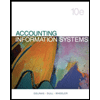Tests of Controls: Input Controls. Knight Company is a medium-size manufacturingentity that uses an automated transaction system to process its customer orders. Orders arecollected and processed on a daily basis in batches. In its processing of customer orders,Knight requires input of the following information into a daily customer order file (# represents a numeric field; A represents an alphabetic field):∙ Customer number (###).∙ Item number (AA###).∙ Quantities (##).After this information has been entered, the computer program accesses the valid customer master file to ensure that the sale is to an authorized customer and does not exceedthat customer’s credit limit. The program then accesses the inventory master file, verifiesthat the appropriate quantities are on hand, and identifies the most current price. The program then prepares an invoice by multiplying the quantities the customer ordered by theappropriate price and generates a total amount for the sale.To prevent and detect errors during the input process, Knight has established the following controls:1. Data entry personnel must enter a valid password to access the data entry program.2. A check digit is appended to the customer number as a seventh digit.3. The following control totals are manually determined prior to input and then comparedto a total generated by the computer program: (a) number of records entered, (b) sum ofcustomer numbers, and (c) sum of quantities.4. The program rejects a customer number or inventory quantity containing an alphabetic character and any entry for item numbers having an inappropriate character in the given field. Dataentry personnel are prompted to reenter the information upon rejection of the original entry.5. Any quantities ordered in excess of 9,999 are highly unusual and require special authorization by Knight’s management. Any such entries are rejected and written to a rejectedorder file for follow-up and authorization. 6. If data entry is attempted for a customer whose number is not in the customer master file(either a new customer or an erroneous entry for an existing customer), the transactionis rejected and written to a rejected order file. Depending on the reason for the invalidcustomer number, a credit check is conducted (if an order from a new customer) or theentry is corrected (if an erroneous entry of the customer number).Required:Consider the four methods of testing the operating effectiveness of controls (inquiry, observation, document examination, and reperformance). For each of the preceding controls, providean example of how Knight’s audit team might choose to test the operating effectiveness of thecontrol using the four methods of test of controls (e.g., how would the audit team use inquiry,observation, document examination, and reperformance to test control #1, use of valid passwords?). [Note: Not all types of tests of controls are appropriate for testing all of the controls.]
Tests of Controls: Input Controls. Knight Company is a medium-size manufacturing
entity that uses an automated transaction system to process its customer orders. Orders are
collected and processed on a daily basis in batches. In its processing of customer orders,
Knight requires input of the following information into a daily customer order file (# represents a numeric field; A represents an alphabetic field):
∙ Customer number (###).
∙ Item number (AA###).
∙ Quantities (##).
After this information has been entered, the computer program accesses the valid customer master file to ensure that the sale is to an authorized customer and does not exceed
that customer’s credit limit. The program then accesses the inventory master file, verifies
that the appropriate quantities are on hand, and identifies the most current price. The program then prepares an invoice by multiplying the quantities the customer ordered by the
appropriate price and generates a total amount for the sale.
To prevent and detect errors during the input process, Knight has established the following controls:
1. Data entry personnel must enter a valid password to access the data entry program.
2. A check digit is appended to the customer number as a seventh digit.
3. The following control totals are manually determined prior to input and then compared
to a total generated by the computer program: (a) number of records entered, (b) sum of
customer numbers, and (c) sum of quantities.
4. The program rejects a customer number or inventory quantity containing an alphabetic character and any entry for item numbers having an inappropriate character in the given field. Data
entry personnel are prompted to reenter the information upon rejection of the original entry.
5. Any quantities ordered in excess of 9,999 are highly unusual and require special authorization by Knight’s management. Any such entries are rejected and written to a rejected
order file for follow-up and authorization.
6. If data entry is attempted for a customer whose number is not in the customer master file
(either a new customer or an erroneous entry for an existing customer), the transaction
is rejected and written to a rejected order file. Depending on the reason for the invalid
customer number, a credit check is conducted (if an order from a new customer) or the
entry is corrected (if an erroneous entry of the customer number).
Required:
Consider the four methods of testing the operating effectiveness of controls (inquiry, observation, document examination, and reperformance). For each of the preceding controls, provide
an example of how Knight’s audit team might choose to test the operating effectiveness of the
control using the four methods of test of controls (e.g., how would the audit team use inquiry,
observation, document examination, and reperformance to test control #1, use of valid passwords?). [Note: Not all types of tests of controls are appropriate for testing all of the controls.]
Trending now
This is a popular solution!
Step by step
Solved in 2 steps








